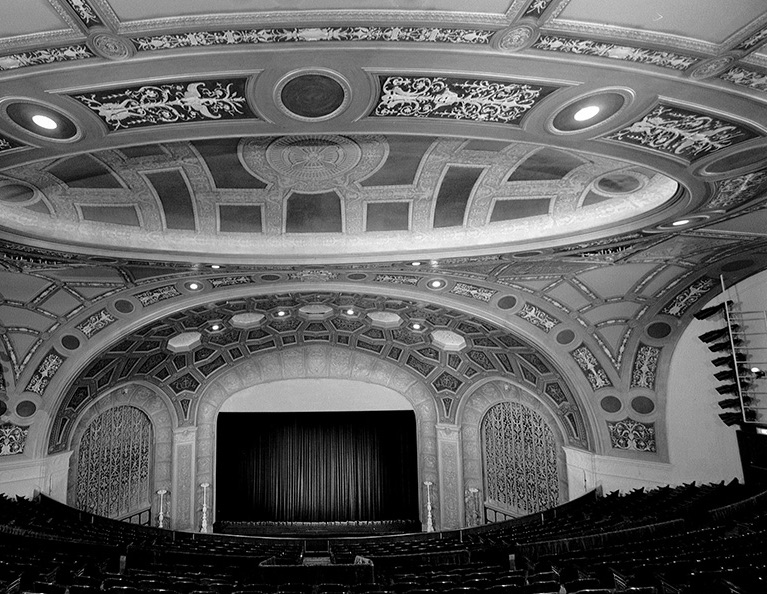[ad_1]

F. Scott Fitzgerald famously wrote that there are no second acts in American lives. That axiom could also be applied to American theaters. So many once-elegant auditoriums have been abandoned, left to decay, then reduced to rubble by the wrecking ball.
That seemed to be the likely fate of the old Grand Circus Theatre (now the Detroit Opera House) on Broadway in downtown Detroit. The building sat empty between 1985 and 1988, and what vandals and squatters didn’t steal, the elements ravaged. Not only was it left without heat and electricity, but a leaky roof resulted in chunks of falling plaster, an orchestra pit that resembled a lake, and gaping holes in the stage.
“This was definitely demolition by neglect,” says Michael Hauser, co-author (with Marianne Weldon) of a new book on the history of the theater titled Detroit Opera House.
“This was prevalent among a lot of the abandoned buildings downtown,” he says. “People could just come in and take whatever they wanted or destroy anything they wanted with no repercussions.”
At the time it looked like curtains for the theater, which opened 100 years ago, in 1922. In 1988, along came a white knight, David DiChiera, founder of Michigan Opera Theatre — recently renamed Detroit Opera. He faced the demanding project with a mixture of cockeyed optimism and steely determination. His then-rootless company had rented various venues, including the Music Hall, the Fisher Theatre, and Masonic Temple, but DiChiera (1935-2018) insisted on a permanent home — and he wanted it in the city of Detroit. Eventually that happened, when the gloriously restored building opened to the public in 1996.

But there were folks who thought DiChiera had gone loco.
“There was some pushback from certain board members and the public,” Hauser says. “I think they wanted the opera company to be on Big Beaver. But David never wavered.”
Hauser, an east-side Detroit resident, was an eyewitness to the transformation. His association with the venue began in 1989 as a volunteer. “I did a lot of cleanup and then worked on the capital campaign and was able to get furnishings donated for all the star dressing rooms,” he says. He was made marketing manager in 2001, a position he retains.
Hauser comes by his affection for old cinemas honestly. He worked as advertising manager for several theaters in his native Grand Rapids and is the co-author of Detroit’s Downtown Movie Palaces.
The Detroit Opera House, designed by C. Howard Crane, is only the latest in a series of venue names. It opened as the Capitol, changed its name to the Paramount in 1929, then became the Broadway Capitol in 1934, followed by the Grand Circus in 1960, and finally the Detroit Opera House.
Through the years, all types of entertainment were offered, including vaudeville, films, opera, big bands and jazz, and radio broadcasts, as well as special appearances by actors. In the early ’80s, live performances by such acts as the Plasmatics, The B-52’s, and The Clash rocked the rafters.

From the 1920s through the ’40s, as many as 35,000 people patronized the theater each day. The venue also has faced tough times, but its management adapted to changing tastes in order to survive. In the 1950s, as television lured many away from cinemas, the Grand Circus showed horror and teenage rock ’n’ roll flicks. In the late ’60s and ’70s, kung fu and “blaxploitation” films adorned the marquee.
“All the downtown theaters had to show these films in order to keep the doors open,” Hauser says. “This building has survived wars, the Depression, civil disturbances, the decline of downtown, and technological changes. Every time we were down, we got right back up again,” he says.
Today, the auditorium is home not only to opera but also to Broadway musicals and other shows. Some have even rented the space for weddings. It was definitely ready for its Hollywood close-up when the 2011 comedy film A Very Harold & Kumar Christmas was shot there, even though it was in July.
“The Radio City Spectacular was done on our stage with Neil Patrick Harris and faux Rockettes,” Hauser says.
“The lobby became a nightclub, and Harris meets Jesus at the top of the grand staircase.”
With a star turn like that, the theater will likely be blessed with another century of entertainment.
This story is from the July 2022 issue of Hour Detroit magazine. Read more stories in our digital edition.
[ad_2]
Source link


:strip_icc()/BHG_PTSN19720-33d9cd22f6ab49e6a21982e451321898.jpg)

More Stories
Pioneers Go East Collective Presents Out-FRONT! Fest.
Henry Hang – Le Degas De La Street Dance
Photographer Masayuki Oki Focuses a Humorous Lens on Japan’s Feline Residents — Colossal